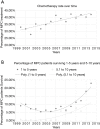Treatment and survival rates of stage IV pancreatic cancer at VA hospitals: a nation-wide study
- PMID: 31392051
- PMCID: PMC6657314
- DOI: 10.21037/jgo.2018.07.08
Treatment and survival rates of stage IV pancreatic cancer at VA hospitals: a nation-wide study
Abstract
Background: Metastatic pancreatic cancer (MPC) is associated with an extremely high mortality. Current NCCN guidelines recommend systemic therapy, as it is superior to best supportive care. Undertreatment of MPC continues to be an issue. Recent treatment and survival data of MPC in Veterans' Affairs' (VA) hospitals have not been published. The relationship between MPC treatment and survival and the American College of Surgeons' (ACS) Committee on Cancer (CoC) accreditation in VA hospitals has not been studied.
Methods: Nationwide data from the National Veterans Affairs Cancer Cube Registry was analyzed. In total, 6,775 patients were diagnosed with MPC between 2000 and 2014. CoC accreditation of each VA hospital was obtained using the ACS website.
Results: MPC constitutes 52.31% of all pancreatic cancer diagnosed (6,775/12,951 cases). The near totality was men (97.44%). The above 70 years age group and the 60-70 years age group were the most common ages at diagnosis with 39.39% and 38.02% respectively. The proportion of early-onset pancreatic cancer (EOPC) was 2.84%. When compared to all stages of pancreatic cancer, stage IV pancreatic cancer had a lower proportion of cancer originating from the head of the pancreas (39.33% versus 50.63%) and more originating from the tail (17.99% versus 13.39%). Tumors originating from head of the pancreas are more likely to cause biliary symptoms and thus are more likely to be caught at an earlier stage. Overall, treatment rate in the VA at the national level with first-line chemotherapy was 37.61%. The rate of treatment over the years has increased in a linear fashion from 33.01% in 2000 to 41.95% in 2014. This has corresponded with an increase of 1-5 years survival of 9.29% in 2000 to 22.99% in 2014 and 5-10 years survival from 0.96% in 2000 to 6.00% in 2012. Treatment rates in CoC-accredited and non-CoC accredited VA hospitals were similar (38.94% and 38.12%, respectively). Survival rates in CoC-accredited and non-COC accredited VAs were similar with a 1-5 years survival rate of 8.89% and 8.57%, respectively.
Conclusions: Treatment and survival of MPC have risen significantly in the past decade at VA hospitals. CoC accreditation is not associated with a change in treatment or survival rates.
Keywords: Pancreatic neoplasms; pancreatic neoplasms/classification; pancreatic neoplasms/epidemiology; pancreatic neoplasms/therapy.
Conflict of interest statement
Conflicts of Interest: The authors have no conflicts of interest to declare.
Figures






References
-
- NCCN Guidelines Pancreatic adenocarcinoma. Version 3. 2017.
LinkOut - more resources
Full Text Sources
Miscellaneous
